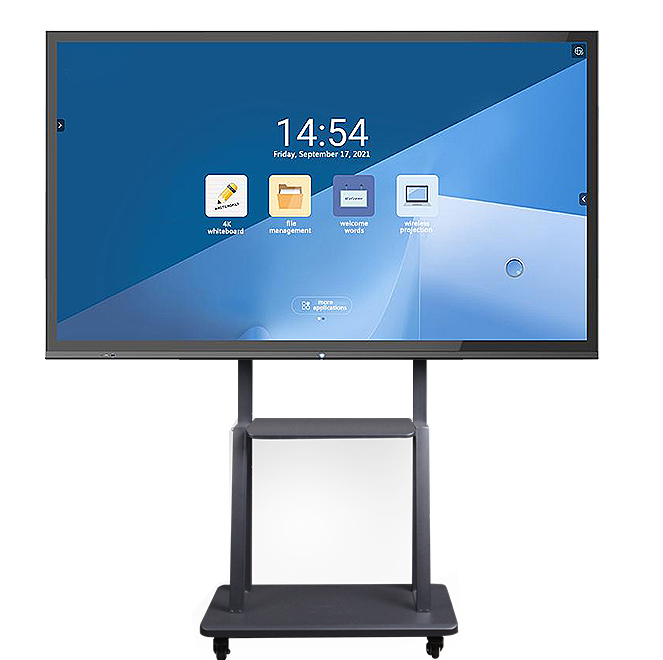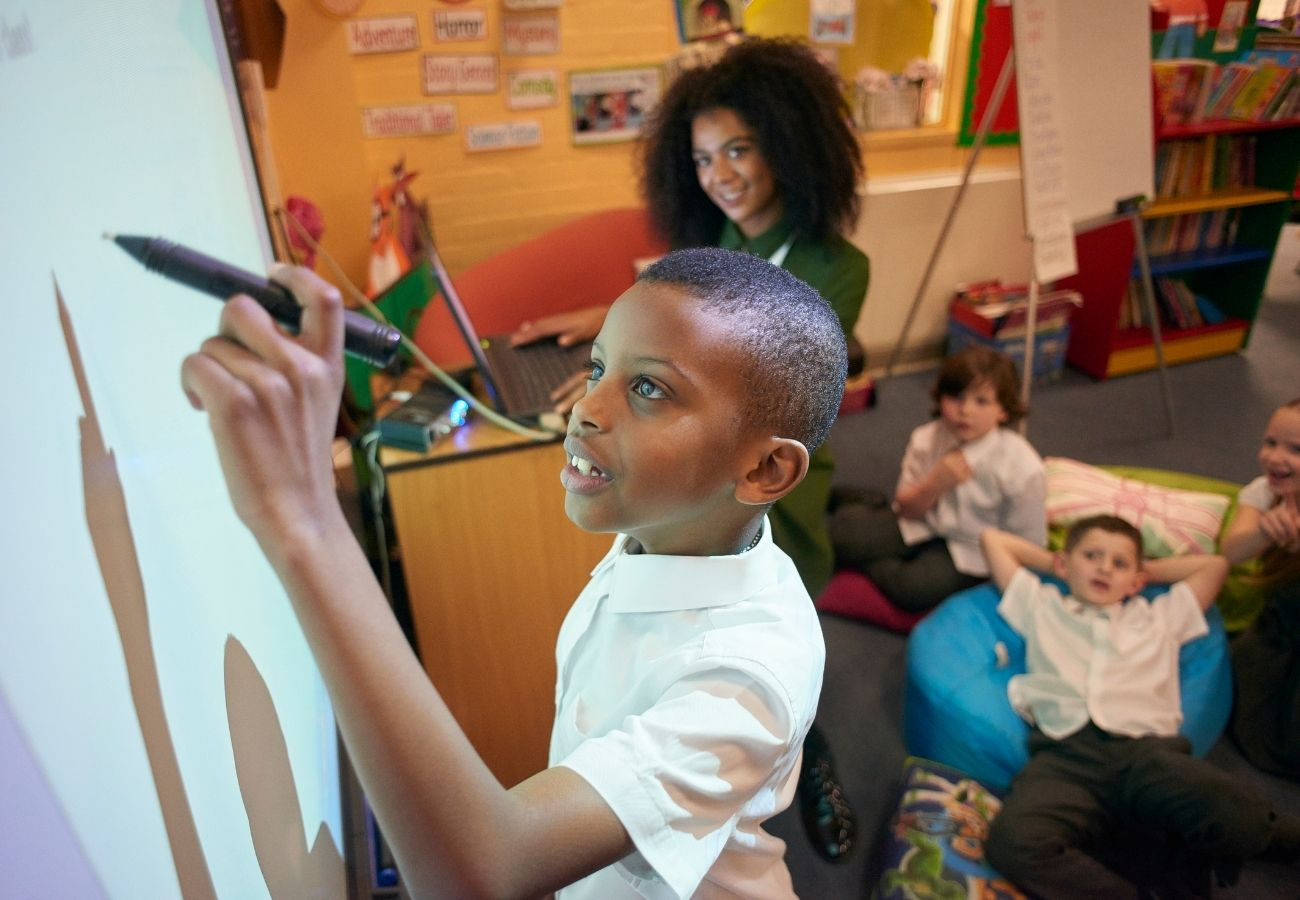Introduction
Interactive learning has become a cornerstone of modern education, aiming to engage students actively and foster deeper understanding. Among the myriad tools transforming classrooms, smart boards stand out for their ability to revolutionize traditional teaching methods. In this blog post, we’ll explore how smart boards enhance education through interactive learning experiences, collaboration, personalized instruction, accessibility, real-world application, data-driven instruction, and professional development support.
Interactive Learning Experiences
Interactive learning experiences with smart boards have revolutionized the way educators engage students in the classroom, fostering a more collaborative, dynamic, and technology-driven learning environment. Smart boards, also known as interactive whiteboards, combine the functionality of traditional whiteboards with advanced digital capabilities, allowing teachers and students to interact with multimedia content, software applications, and the internet in real-time. Here are some key features and benefits of using smart boards to create immersive and interactive learning experiences:
Multimedia Integration
Smart boards enable teachers to incorporate a wide range of multimedia resources into their lessons, such as videos, images, audio clips, and animations. This not only enhances the visual appeal of the lesson but also caters to different learning styles, making the content more accessible and engaging for diverse student populations.
Interactive Content Manipulation
With touch or stylus input, students can directly interact with on-screen content, manipulating objects, solving problems, and participating in simulations. This hands-on approach promotes active learning, deepens understanding, and enhances retention of concepts. For example, students can work together on a virtual science experiment, solve math equations, or annotate historical maps.
Collaborative Learning
Smart boards facilitate group activities and collaborative work, fostering a sense of teamwork and peer-to-peer learning. Multiple students can simultaneously interact with the board, brainstorm ideas, solve problems, or contribute to a shared project. This collaborative environment encourages communication, critical thinking, and problem-solving skills.
Real-time Feedback and Assessment
Teachers can use smart boards to administer quizzes, polls, and surveys, providing instant feedback to both students and teachers. This real-time assessment helps teachers gauge student understanding, adjust instruction on the fly, and address misconceptions immediately. Students benefit from immediate feedback, which allows them to identify areas for improvement and track their progress.
Integration with Educational Software and Apps
Smart boards seamlessly integrate with various educational software and apps, such as interactive lesson planning tools, educational games, and online resources. This integration extends the functionality of the smart board, offering endless possibilities for customized and differentiated learning experiences.
Virtual and Remote Learning Support
In today’s hybrid or remote learning scenarios, smart boards can be connected to video conferencing platforms, enabling teachers to share their screen with remote students. This feature ensures that all students, whether physically present or attending virtually, can actively participate in the same interactive learning experience.
Recorded Lessons and Review Materials
Many smart board systems allow teachers to record their lessons, including annotations, student contributions, and multimedia elements. These recordings can be shared with students for review, absentees, or flipped classroom scenarios, providing an invaluable resource for self-paced learning and reinforcement.
Environmental Awareness and Sustainability
By reducing the need for printed materials and promoting digital resources, smart boards contribute to a more environmentally friendly classroom. Additionally, they help save time and resources by eliminating the need for manual note-taking and transcribing, as everything can be saved digitally for future reference.
In summary, interactive learning experiences with smart boards offer a powerful and versatile tool for educators to create engaging, collaborative, and technology-enhanced lessons. By leveraging the numerous features and benefits of smart boards, teachers can cater to diverse learning styles, promote active participation, and foster a dynamic, 21st-century learning environment.
Collaboration and Communication
Smart boards facilitate collaboration and communication among students and educators. With touchscreen interactivity and digital annotation tools, students can work together on projects, brainstorm ideas, and share findings in real-time. This collaborative approach fosters teamwork, communication skills, and peer-to-peer learning. Educators can also use smart boards to facilitate class discussions, gather feedback, and provide instant clarification, creating a more interactive and engaging learning environment.
Personalized Instruction
Smart boards enable educators to personalize instruction to meet the diverse needs of students. With customizable lesson templates, adaptive learning software, and real-time assessment tools, teachers can tailor instruction based on students’ strengths, weaknesses, and interests. Whether it’s providing extra practice for struggling students, challenging advanced learners, or accommodating different learning modalities, smart boards support personalized learning experiences that maximize student engagement and success.
Accessibility and Inclusivity
Smart boards promote accessibility and inclusivity by providing equitable learning opportunities for all students. Features like voice commands, screen readers, and adjustable font sizes accommodate students with disabilities and learning differences, ensuring that everyone can participate actively in classroom activities. Additionally, smart boards offer multisensory learning experiences that appeal to diverse learning styles, making education more accessible and engaging for all students.
Real-World Application
Smart boards prepare students for success in the digital age by promoting real-world skills and digital literacy. By interacting with technology daily, students develop essential skills like information literacy, critical thinking, and problem-solving. Smart boards expose students to a variety of digital tools and resources, such as online research, multimedia presentations, and collaborative platforms, preparing them for higher education and the workforce.
Data-Driven Instruction
Smart boards empower educators to make data-driven instructional decisions and continuously improve teaching practices. With built-in assessment tools, learning analytics, and progress tracking features, teachers can gather real-time data on student performance and engagement. This data allows educators to identify areas of strength and weakness, adjust instruction accordingly, and provide targeted support to students, optimizing learning experiences and maximizing student success.
Professional Development Support
Successful implementation of smart board requires ongoing professional development and support for educators. Schools can offer comprehensive training programs, hands-on workshops, and curriculum integration support to help teachers effectively integrate smart board technology into their teaching practices. Ongoing coaching, peer collaboration, and access to technical support resources ensure that teachers feel confident and supported in using smart board to enhance student learning experiences.
Conclusion
Smart boards have transformed education by promoting interactive learning experiences, collaboration, personalized instruction, accessibility, real-world application, data-driven instruction, and professional development support. By leveraging the power of smart board technology, educators can create dynamic and engaging learning environments that cater to the diverse needs of today’s students, preparing them for success in the digital age and beyond.





